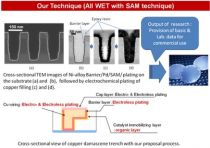All Wet ULSI manufacturing process

- researcher's name
- affiliation
-
- research field
-
Device related chemistry,Nanobioscience,Electronic materials/Electric materials
- keyword
-
background
Most metal wiring used in ULSI is mostly made from a barrier layer and copper piping. The barrier layer is constructed to prevent the leakage of copper onto Si substrates. Today’s process rules call for efforts to create thinner and more compact chips of only a few nanometers in thickness. In addition, there is demand for super filling that does not cause any defects to arise within trenches, where we continue to see efforts to further compact and improve aspect ratios of copper fillings. There is also a need to fulfill the condition of enabling low cost processes within these structures.
summary
This project proposes the creation of a barrier layer structure on top of a silicon substrate, low-k substrate, and polyimide substrate and then cooper wiring after that. The project aims to confirm that it is possible to shrink barrier film made with electroless plating to a thickness of 6 nm. Success has been made in embedding copper in a fine trench and constructing a protective layer using electroless and electro-plating.
application/development
The project relates to wiring and interconnection technology for wiring in ULSI, semiconductor packages, and signal transfers between electric circuits, and these can be applied to all differing order circuitry.
predominance
This technology is perfect for ULSI wiring, and it is possible to apply an all-wet method to the full execution of the wiring process. It is thought that there is a need for the construction of barrier film and the thinning of barriers when wiring within semiconductor packages and electric circuitry parts due to the miniaturization of these packages and circuitry parts. This technology allows for the use of ULSI technology without having to select substrate materials, making it useful for future technology.
purpose of providing seeds
Sponsord research, Collaboration research, Technical consultation
same researcher's seeds
-
 Field Effect Transistor Sensor
Field Effect Transistor Sensor
-
 Manufacturing of nano particle array substrates
Manufacturing of nano particle array substrates
-
 Hard-gold film technology for the realization of low-resistance and high mechanical strength
Hard-gold film technology for the realization of low-resistance and high mechanical strength
-
 Evaluating lithium-ion battery (LIB) cell degradation using an impedance measurement
Evaluating lithium-ion battery (LIB) cell degradation using an impedance measurement
-
 Long-life negative silicon anode synthesis for next-generation lithium-ion batteries
Long-life negative silicon anode synthesis for next-generation lithium-ion batteries
-
 Production technology development for the creation of a next-generation laminated lithium-ion battery
Production technology development for the creation of a next-generation laminated lithium-ion battery
-
 Monitoring Chemical Balance in Epidermal Barriers
Monitoring Chemical Balance in Epidermal Barriers
-
 Development of Biosensing Technology for Food Safety
Development of Biosensing Technology for Food Safety
-
 Development of magnetic nanoparticles for cancer care
Development of magnetic nanoparticles for cancer care
-
 Chemical Health Monitor Kind to Skin
Chemical Health Monitor Kind to Skin
-
 Seeing mental stress from invisible substances
Seeing mental stress from invisible substances
-
 Battery Diagnosis by Square-Current Electrochemical Impedance Spectroscopy
Battery Diagnosis by Square-Current Electrochemical Impedance Spectroscopy
posted:
2014/05/21



